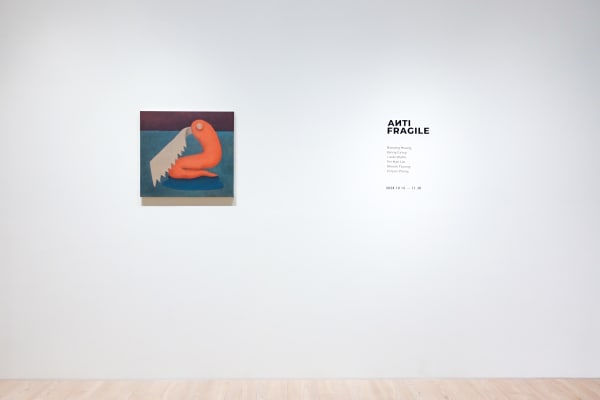ANTIFRAGILE
■ 開幕 Opening | 10 / 12 (Sat) 3 PM
■ 地點 Venue | 大河美術 RIVER ART GALLERY
大河美術將舉辦女性聯展《ANTIFRAGILE》,邀請到 6 位來自不同國家的女性藝術家,包含來自美國的 Ginny Casey、英國的 Linda Wallis、加拿大的 Winnie Truong、旅居挪威的臺灣藝術家林沛含,以及分別活躍於德國與紐約的中國藝術家張新顏與黃寶瑩。透過各具特色的創作,探討如何在當今充滿不確定性、混亂與挑戰的時代中,不僅能從容應對衝擊,且能從中成長茁壯。
搬運玻璃等易碎品時經常會標上「Fragile(脆弱的)」的標籤以提醒物流人員。然而繁複的包裝並未改變內容物的本質,因此「反脆弱(Antifragile)」一詞即點出,脆弱的反義詞並非堅強,而是擁有抵抗壓力的柔韌與彈性。展覽的主視覺也呼應了這個概念,藝廊外部的燈箱如同一張標示著「反脆弱」的標籤,貼於象徵著運輸紙箱的藝廊上,而藝術家們則是箱內那些「看似脆弱,實際上卻擁有高度韌性和適應能力」的存在。從前段全球疫情肆虐與後疫情時期,到當前面臨安全危機、政局動蕩和氣候變化等背景下,這樣的概念亦成為許多領域強調必須培養的關鍵能力。2022 年第十六屆里昂雙年展的策展人 Sam Bardaouil 和 Till Fellrath 重新思考脆弱性的意義,並以「脆弱宣言(Manifesto of Fragility)」作為雙年展主題,引發廣泛迴響;而兩位也將在 2025 年第十四屆臺北雙年展中擔任策展人,提醒著臺灣早已深陷這樣的全球語境中。
本次展覽由美國藝術家 Ginny Casey 率先開啟這段旅程。她探索有機物與人造物之間的交互作用,視覺語言整體透著懸浮的大氣氛圍,透過柔和但隱含戲劇張力的色調、擬人化的物件以及細膩的隱喻,使其在創作中表達自身多層次的情感與反思。中國藝術家張新顏則長期關注女性與兒童等多數社會中的弱勢族群議題,創作形式同時擁有西方藝術史中的後表現主義及傳統中國繪畫的特點,透過真實事件作為題材,同時藉由碎片化和重組來探討流行文化影響下的「人性脆弱」和「人類生存的共性狀態」,影射現代人心靈的腐朽與破碎,也傳達出面對變動與困境的堅韌意志。英國藝術家 Linda Wallis 則藉由無意識的具現,使得與生俱來的想像力和創造力得以自由表達,加上顏色的層疊,最終讓觀者在想像與視覺重合之時,感受到幽默又微妙的既視感。
中國藝術家黃寶瑩的創作聚焦於與個人緊密相關的物件。面對日常的境遇與現實殘酷的無力感,促使她將創作視為「流浪」思緒的容器,同時也是她自我整理並與外部世界和解的過程。加拿大藝術家 Winnie Truong 主要通過傳統繪畫和剪紙拼貼來探討身份認同、女性主義等議題,以一種獨特的「異域女性自然主義者」身份之想像視角,細緻入微地呈現自然界與超自然界交錯時的張力,促使個體在有限的身份與經歷中,進行更深刻的自我反思。最後,臺灣藝術家林沛含致力於探索文化、記憶與身份認同之間的交錯,邀請觀者進行批判性的對話與深度反思,揭示文化遺產和集體記憶的複雜性,並且針對巴爾幹地區、薩米族群與她自身國家共同面對的殖民經驗與文化抹滅問題,進行更深切的討論。
大河美術期望與觀眾共同探討展覽主題及各作品之間的深層意涵,藉此激勵人們在充滿變動與不確定的時代中,不斷反思如何在動盪中尋求突破的可能,並探索與脆弱和挑戰共存的方法。同時,也向這個時代的人類提出一道終生課題──回顧過去至今,全球對「反脆弱」的思考似已進入尾聲,然而面對國際情勢日益升溫,2025 年之後的未來又將帶來什麼樣的新挑戰,如同展覽在最後提出的那句「How do we live?」,值得我們深思。
RIVER ART GALLERY will host a group show of female artists titled “ANTIFRAGILE,” featuring six artists from different countries: Ginny Casey from the United States, Linda Wallis from the United Kingdom, Winnie Truong from Canada, and Taiwanese artist Pei-Han Lin, who currently resides in Norway, along with Chinese artists Xinyan Zhang, based in Germany, and Baoying Huang, based in New York. Through their distinctive creations, this show explores how to not only navigate the uncertainties, chaos, and challenges of today's world but also to thrive amidst them.
When handling delicate items like glass, they are often labeled “Fragile” to alert logistics personnel. However, complex packaging does not change the essence of the contents; thus, the term “Antifragile” highlights that the opposite of fragility is not strength, but rather resilience and flexibility in the face of pressure. This concept is echoed in the exhibition's main visual identity, where the gallery's external lightbox resembles a label marked “Antifragile” affixed to the gallery’s building, which symbolizes a shipping box. The artists, in turn, represent the seemingly fragile objects inside the box, yet embody remarkable resilience and adaptability. From the global pandemic and post-pandemic periods, to the current crises of security, political instability, and climate change, this concept of “Antifragility” has become a critical capability across various domains. At the 16th Lyon Biennale in 2022, curators Sam Bardaouil and Till Fellrath reexamined the meaning of fragility, making the “Manifesto of Fragility” the theme of the biennale, which resonated widely. Both curators will also oversee the 14th Taipei Biennale in 2025, further underscoring Taiwan's embeddedness in this global discourse.
The show journey is initiated by American artist Ginny Casey, who explores the interaction between organic and man-made objects. Her visual language exudes an overall atmosphere of suspension, using soft yet subtly dramatic tones, anthropomorphized objects, and delicate metaphors to express her multilayered emotions and reflections. Chinese artist Xinyan Zhang, who has long focused on issues affecting marginalized groups such as women and children, incorporates elements of post-expressionism from Western art history and traditional Chinese painting. By addressing real events, she uses fragmentation and reassembly to explore the themes of “the fragility of human nature” and “the shared condition of human existence” under the influence of popular culture, reflecting the decay and fragmentation of modern human psyche while conveying a resilient spirit in the face of change and adversity. British artist Linda Wallis expresses innate imagination and creativity through unconscious manifestations. Through layered colors, she ultimately evokes a humorous yet subtle sense of déjà vu when the viewer's imagination overlaps with the visual.
Chinese artist Baoying Huang’s work focuses on objects closely tied to personal experiences. Confronted by the daily circumstances of life and the harsh powerlessness of reality, she views her work as a vessel for the “nomad” thoughts, serving as a process of self-reflection and reconciliation with the outside world. Canadian Artist Winnie Truong primarily employs traditional drawing and cut paper collage to explore themes of identity and feminism, presenting a nuanced tension at the intersection of natural and supernatural realms through the imaginative perspective of “a feminist naturalist from another realm,” prompting deeper introspection within one's limited identities and experiences. Lastly, Taiwanese artist Pei-Han Lin is dedicated to exploring the intersections of culture, memory, and identity, inviting viewers to engage in critical dialogue and deep reflection on the complexities of cultural heritage and collective memory. She addresses a deeper discussion of the shared colonial experiences and cultural erasure faced by the Balkan region, the Sámi people, and her own country.
RIVER ART GALLERY aims to engage viewers in a deeper exploration of the exhibition’s theme and the intrinsic meanings within each artwork. Through this process, the show seeks to inspire individuals to continually reflect on how to navigate uncertainty and upheaval, and to find ways to coexist with fragility and challenges in these turbulent times. It also presents a lifelong question to humanity in this era: as we look back on the global discourse around “Antifragility,” which appears to have reached a pivotal moment, what new challenges might the world face in the post-2025 era as international tensions escalate? As the exhibition concludes with the poignant question, “How do we live?”, it is a topic worthy of deep contemplation.
















